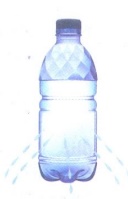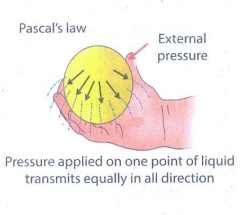Chapter 2 | 8th Science - Force and Pressure in Liquids | 8th Science : Chapter 2 : Force and Pressure
Chapter: 8th Science : Chapter 2 : Force and Pressure
Force and Pressure in Liquids
Force and Pressure
in Liquids
You
would have noticed that an upward force is exerted by water on a floating or a
partly submerged body. This upward force is called buoyant force . This phenomenon is known as buoyancy. This force is not only exerted by liquids, but also by
gases.
This
upward force decides whether an object will sink or float. If the weight of the
object is less than the upward force, then the object will float. If not, it
will sink.
1. Pressure exerted by Liquids
Liquids
exert a pressure not only on the base of the container/vessel in which they are
kept, but also on the side walls. The pressure exerted by a liquid depends on
the depth of the point of observation considered in it.
Activity 3
Take a plastic bottle. Punch three holes on its side in the same
direction, but at different heights. Now pour some water into it and let it
flow through the holes. Observe the flow of water. Water from the lowest hole
comes out with the greatest force and the water from the topmost hole comes out
with the least force.

Answer:
Aim : To understand that the pressure in a liquid varies with the
depth of the point of observation in it.
Materials
required : Plastic bottle, Water
(i) Plastic bottle
(ii) Water
Procedure
:
(i) Take a plastic bottle.
(ii) Punch three holes on its sides in the same direction but at
different heights.
(iii) Now pour some water into it and let it flow through the
holes.
(iv) Observe the flow of water.
Observation:
i) The water comes out from all the holes with a different force
and falls on the table at points that are at variable distances from the
bottle.
(ii) Water from the lowest hole comes out with the greater force
and falls at a point that is at the maximum distance from the bottle.
(iii) Water from the top most hole comes but with the least
force and falls at the point that is at the minimum distance from the bottle.
Inference: This shows that the pressure is a liquid varies with the depth of the point of observation on it.
Answer 2 : Take a plastic bottle. Punch three holes on its side in the same direction, but at different heights. Now pour some water into it and let it flow through the holes. Observe the flow of water.
Inference
: The water comes out from all the holes with a different force
and falls on the table at points that are at variable distances from the
bottle. Water from the lowest hole comes out with the greatest force and falls
at a point that is at the maximum distance from the bottle. Water from the
topmost hole comes out with the least force and falls at the point that is at
the minimum distance from the bottle.
Reason: This activity confirms that the pressure in a liquid varies
with the depth of the point of observation in it.
This
activity confirms that the pressure in a liquid varies with the depth of the
point of observation in it.
Activity 4
Take a glass tube that is open at both ends. Fix a rubber
balloon at the lower end of the tube. Pour some water into the tube and observe
the balloon. Now, pour some more water into the balloon and again observe the
balloon. The balloon starts bulging outwards.
Answer:
Aim : To demonstrate that liquid exerts pressure at the bottom of
its container depends on the height of the liquid column in it.
Materials
required ; Transparent glass tube, balloon,
water.
Procedure
:
(i) Take a glass tube that is open at both ends.
(ii) Fix a rubber balloon at the lower end of the tube.
(iii) Put some water into the tube and observe the balloon.
(iv) Now, pour some more water into the balloon and again
observe the balloon.
Observation
: The balloon starts bulging outwards. The bulge increase with an
increase in the height of the water column.
Inference: The pressure exerted by a liquid at the bottom of a container
depends on the height of the liquid column in it.
This
shows that the pressure exerted by a liquid at the bottom of a container
depends on the height of the liquid column in it.
Activity 5
Take a plastic bottle. Punch three holes on its sides at the
same height from its base. Now, pour some water into it and let it flow through
the holes. Observe the flow of the water. Water comes out from all the holes
with the same force and falls on the ground/ table, at the same distance from
the bottle.
Answer:
Aim : To demonstrate that liquid exerts equal pressure at same
depth.
Material
required : Plastic bottle, water.
Procedure
:
(i) Take a plastic bottle.
(ii) Punch three holes on its sides at the same height from its
base.
(iii) Now, pour some water into it and let it flow through the
holes.
(iv) Observe the flow of the water.

Observation
: The water comes out from all the holes with the same force and
falls on the ground / table, at the same distance from the bottle.
Inference
: This activity confirms that liquids exert the same pressure in
all directions at a given depth in their container.
Thus,
we can conclude that liquids exert the same pressure in all directions, at a
given depth.
Why dams are made stronger and broader at the bottom than at the
top? Why do scuba divers wear a special suit while they go into deep sea
levels?
2. Pascal’s Law
Activity 6
Take a rubber ball and fill it with water. Make tiny holes on
its surface with a pin at different points. Press anywhere on the ball. What do
you observe?
Answer:
Aim : To demonstrate pressure applied on one point of liquid
transmits equally in all directions.
Materials
required : Rubber ball, water, pin.
Procedure
:
(i) Take a rubber ball. Fill it with water.
(ii) Then take tiny holes on it with a pin at different points
on its surface.
(iii) Press anywhere on the ball.
(iv) What do you observe?

Observation
: There are identical streams of water flowing in all directions
from the holes.
Inference
: This is due to the phenomenon that the pressure, which is
applied on the liquid, is equally transmitted in all directions.
You
can see identical streams of water flowing in all directions from the holes.
This is due to the fact that the pressure, which is applied on the liquid, is
equally transmitted in all direction. This concept was first given by the
French scientist Blasie Pascal.
Pascal's
law states that the pressure applied at any point of a liquid at rest, in a
closed system, will be distributed equally through all directions of the liquid.
Applications of Pascal’s Law
The applications of Pascal’s law
are:
* In
automobile service stations, the vehicles are lifted upward using the hydraulic
lift which works as per Pascal’s law.
* Automobile
brake system works according to Pascal’s law.
* The
hydraulic press is used to compress the bundles of cotton or cloth so as to
occupy less space.
Related Topics